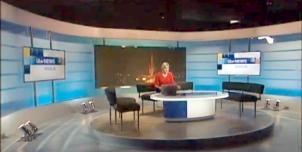Full Freeview on the Sudbury (Suffolk, England) transmitter
| Google Streetview | Google map | Bing map | Google Earth | 52.005,0.786 or 52°0'17"N 0°47'8"E | CO10 5NG |
The symbol shows the location of the Sudbury (Suffolk, England) transmitter which serves 440,000 homes. The bright green areas shown where the signal from this transmitter is strong, dark green areas are poorer signals. Those parts shown in yellow may have interference on the same frequency from other masts.
This transmitter has no current reported problems
The BBC and Digital UK report there are no faults or engineering work on the Sudbury (Suffolk, England) transmitter._______
Digital television services are broadcast on a multiplexes (or Mux) where many stations occupy a single broadcast frequency, as shown below.
64QAM 8K 3/4 27.1Mb/s DVB-T MPEG2
H/V: aerial position (horizontal or vertical)
The Sudbury (Suffolk, England) mast is a public service broadcasting (PSB) transmitter, it does not provide these commercial (COM) channels: .
If you want to watch these channels, your aerial must point to one of the 80 Full service Freeview transmitters. For more information see the will there ever be more services on the Freeview Light transmitters? page.
Which Freeview channels does the Sudbury transmitter broadcast?
If you have any kind of Freeview fault, follow this Freeview reset procedure first.Digital television services are broadcast on a multiplexes (or Mux) where many stations occupy a single broadcast frequency, as shown below.
64QAM 8K 3/4 27.1Mb/s DVB-T MPEG2
H/V: aerial position (horizontal or vertical)
The Sudbury (Suffolk, England) mast is a public service broadcasting (PSB) transmitter, it does not provide these commercial (COM) channels: .
If you want to watch these channels, your aerial must point to one of the 80 Full service Freeview transmitters. For more information see the will there ever be more services on the Freeview Light transmitters? page.
Which BBC and ITV regional news can I watch from the Sudbury transmitter?

BBC Look East (East) 0.8m homes 3.2%
from Norwich NR2 1BH, 77km north-northeast (24°)
to BBC East region - 27 masts.
70% of BBC East (East) and BBC East (West) is shared output

ITV Anglia News 0.8m homes 3.2%
from NORWICH NR1 3JG, 78km north-northeast (24°)
to ITV Anglia (East) region - 26 masts.
All of lunch, weekend and 80% evening news is shared with Anglia (West)
Are there any self-help relays?
| Felixstowe West | Transposer | 1000 homes +1000 or more homes due to expansion of affected area? | |
| Witham | Transposer | 14 km NE Chelmsford. | 118 homes |
How will the Sudbury (Suffolk, England) transmission frequencies change over time?
| 1984-97 | 1997-98 | 1998-2011 | 2011-13 | 1 Aug 2018 | |||||
| B E T | B E T | B E T | E T | K T | |||||
| C29 | SDN | ||||||||
| C31 | ArqA | ||||||||
| C35 | C5waves | C5waves | |||||||
| C37 | ArqB | ||||||||
| C41 | ITVwaves | ITVwaves | ITVwaves | D3+4 | D3+4 | ||||
| C44 | BBC2waves | BBC2waves | BBC2waves | BBCA | BBCA | ||||
| C47 | C4waves | C4waves | C4waves | BBCB | BBCB | ||||
| C51tv_off | BBC1waves | BBC1waves | BBC1waves | ||||||
| C56tv_off | ArqB | ||||||||
| C58tv_off | SDN | ||||||||
| C60tv_off | -ArqA |
tv_off Being removed from Freeview (for 5G use) after November 2020 / June 2022 - more
Table shows multiplexes names see this article;
green background for transmission frequencies
Notes: + and - denote 166kHz offset; aerial group are shown as A B C/D E K W T
waves denotes analogue; digital switchover was 6 Jul 11 and 20 Jul 11.
How do the old analogue and currrent digital signal levels compare?
| Analogue 1-4 | 250kW | |
| SDN, ARQA, ARQB, BBCA, D3+4, BBCB | (-4dB) 100kW | |
| Analogue 5 | (-7dB) 50kW | |
| Mux 2* | (-14.9dB) 8.1kW | |
| Mux B* | (-15.2dB) 7.5kW | |
| Mux 1* | (-15.5dB) 7kW | |
| Mux A* | (-17dB) 5kW | |
| Mux C* | (-22.2dB) 1.5kW | |
| Mux D* | (-23.6dB) 1.1kW |
Which companies have run the Channel 3 services in the Sudbury transmitter area
|
|
Saturday, 31 August 2013
N
nick8:00 PM
Thanks JB.
Is it necessary to do a scan when the foreigners come in and perhaps see something? Otherwise I am left with the impression that there is nothing there and lost as to why Sudbury has vanished.
| link to this comment |
J
jb388:55 PM
nick: No, because if you are viewing a programme and it slowly starts to break up and with the reason for suspected as being caused by a rising level of co-channel interference from a foreign station then rescanning would not make any difference, and simply because that the end situation would still be exactly the same.
That being, of the receiver picking up signals from two digital transmitters on the same channel but with the data stream from both corrupting each others in varying degrees dependant on the signal strength ratio between them, partial but intermittent reception only starting to re-appear when the signal from one transmitter has reached a sufficiently high enough level to virtually overpower the other and with "no signal" or just a blank being seen on the receiver whilst it hasn't, albeit of course that the actual signals are still there.
| link to this comment |
K
KMJ,Derby10:26 PM
nick: The Sudbury COM muxes share frequencies with Waltham (C56 & C58) and Belmont (C60). Similarly Dover shares frequencies with Tacolneston (C50, C55, C59) and Sandy Heath (C48 & C51). It is very likely that these transmitters are responsible on many occasions for the interuptions to your normal reception.
| link to this comment |
Sunday, 1 September 2013
J
jb3812:07 AM
nick: With reference to the suggestion made by KMJ,Derby, if when your reception of Sudbury's C56 or C58 is affected in any way then try a "manual" signal check on C49 Waltham's BBC1, or alternatively C57 which is Waltham's COM6 and see if anything is being indicated, because if atmospheric conditions are enabling Waltham's muxes to interfere with your reception from Sudbury then the chances are that its BBC1 and also its COM6 will also be receivable.
If though its Sudbury's C60 that's affected, then should Belmont's C60 be responsible then try a manual tune signal check on Belmont's COM5 on C53 and see if anything is being indicated signal wise.
By the way, the check I refer to is achieved by going into the tuning menu / manual tune and entering the channel number but NOT being followed by pressing search or scan, as on most devices the strength / quality of the mux channel entered will be seen shortly after the channel number has been entered, if search or scan is accidentally pressed the test will be null and void as you will have activated the signal level cut off threshold into the equation.
Those tests are not necessarily 100% accurate, however in most cases they will apply by giving an indication of whether or not the problem is being caused by another UK station rather than a foreign one.
| link to this comment |
N
nick11:08 PM
Thanks KMJ and JB
I suspect the culprit is Holland, but no search when I lose signal from these three Sudbury muxes will help me find out?
C41 and 44 are the same power but don't vanish. Why?
| link to this comment |
Monday, 2 September 2013
J
jb388:09 AM
nick: Its not so much the case that carrying out the procedure as described in my reply will positively pinpoint Holland as being responsible for your difficulties, but more the case checking and possibly eliminating other sources such as mentioned by KMJ.Derby, and although not a 100% accurate test it does at least give you an idea as to whether or not there is even the slightest trace of a signal from either of the stations mentioned, because if there is then both of will come into the equation whereas if not this its inclined to eliminate them as playing any role thereby casting suspicion on Holland as being entirely responsible.
I would like to emphasise that I am not doubting what you have said, but just giving you another way of verifying (or otherwise) what you suspect.
As far as C41 and C44 are concerned, the only reason for this is simply because that the offending source does not transmit on those channels, and of course neither does Waltham or Belmont!
| link to this comment |
N
nick5:34 PM
Thanks JB.
I have mentioned this before, I know.
All my small portables buzz on sound with a freeview box connected via scart, more so on bright pictures, but annoying all the time. Where I have a freeview box, eg Icecypt, which will also work via the aerial connection, there is no problem, although the Icecrypt makes a buzz via scart.
Where the other freeview boxes can only be connected via scart, is there anything possible to stop the buzz?
| link to this comment |
M
MikeB9:37 PM
nick: It sounds like your scart is poorly shielded, and probably very close to other cables. Move them away from each other for a start, possibly change them for better leads (ATV do seemingly very nice ones for only £3.50 Online Satellite/TV/FM/DAB Cable, Leads and Connectors sales. and of course check that you cannot ultimately use HDMI instead (they can also have interference, but probably less than scart).
There are one or two other possibilities, and they are discussed here Suggestions For Fixing Scart Interference On TV? - TV and Home Entertainment Technology - Digital Spy Forums
| link to this comment |
Tuesday, 3 September 2013
J
jb3812:30 AM
nick: When you mention "your small portables" are you referring to digital TV's or analogue ones being used as monitors? the only reason for asking being that on having looked though all of the postings made on MikeB's digital spy forums link one well known reason for this problem being experienced on analogue sets is conspicuous by its absence of being mentioned, namely video overdrive resulting audio buzz and which the intensity / frequency of is heard as being in sympathy with the white level of the picture.
You can up to a point get the same effect on poorly designed digital TV's and due to the following reasons, (1) a combination of PCB tracks of a sensitive nature running too close to each other, or (2) PCB earth loop problems, (3) poorly designed power supplies and which (2) also comes into the equation.
In all of those cases, using excessively high contrast levels on the picture generally results in making the problem worse.
| link to this comment |
N
nick6:09 PM
Thanks JB.
I am talking about all portable 14 inch analogue tvs, CRT, all suffer the same buzz with all boxes connected by scart.
Wish this had been pointed out when I bought the boxes, seems that if I can put up with a murky picture it will have to do, and certainly the buzz intensity changes as the picture changes.. But curious why the problem does not happen on larger crt tvs.
| link to this comment |
Select more comments
Your comment please!




